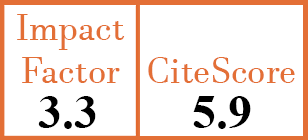Full Papers
Histopathologic differences between cutaneous vasculitis associated with severe bacterial infection and cutaneous vasculitis secondary to other causes: study of 52 patients
J. Loricera1, C. González-Vela2, R. Blanco3, J.L. Hernández4, S. Armesto5, M.A. González-López6, V. Calvo-Río7, F. Ortiz-Sanjuán8, J.F. Val-Bernal9, S. Hermana10, A. Onaindia-Pérez11, M.A. González-Gay12
- Department of Rheumatology, Hospital Universitario Marqués de Valdecilla, IDIVAL, University of Cantabria, Santander, Spain.
- Department of Pathology, Hospital Universitario Marqués de Valdecilla, IDIVAL, University of Cantabria, Santander, Spain.
- Department of Rheumatology, Hospital Universitario Marqués de Valdecilla, IDIVAL, University of Cantabria, Santander, Spain.
- Department of Internal Medicine, Hospital Universitario Marqués de Valdecilla, IDIVAL, University of Cantabria, Santander, Spain.
- Department of Dermatology, Hospital Universitario Marqués de Valdecilla, IDIVAL, University of Cantabria, Santander, Spain.
- Department of Dermatology, Hospital Universitario Marqués de Valdecilla, IDIVAL, University of Cantabria, Santander, Spain.
- Department of Rheumatology, Hospital Universitario Marqués de Valdecilla, IDIVAL, University of Cantabria, Santander, Spain.
- Department of Rheumatology, Hospital Universitario Marqués de Valdecilla, IDIVAL, University of Cantabria, Santander, Spain.
- Department of Pathology, Hospital Universitario Marqués de Valdecilla, IDIVAL, University of Cantabria, Santander, Spain.
- Department of Pathology, Hospital Universitario Marqués de Valdecilla, IDIVAL, University of Cantabria, Santander, Spain.
- Department of Pathology, Hospital Universitario Marqués de Valdecilla, IDIVAL, University of Cantabria, Santander, Spain.
- Department of Rheumatology, Hospital Universitario Marqués de Valdecilla, IDIVAL, University of Cantabria, Santander, Spain. miguelaggay@hotmail.com
CER9231
2016 Vol.34, N°3 ,Suppl.97
PI 0093, PF 0097
Full Papers
Free to view
(click on article PDF icon to read the article)
PMID: 27054275 [PubMed]
Received: 04/01/2016
Accepted : 15/02/2016
In Press: 06/04/2016
Published: 27/05/2016
Abstract
OBJECTIVES:
To determine if cutaneous vasculitis (CV) associated with severe infection has some histopathologic findings that may help us to differentiate patients with this condition from other patients with CV.
METHODS:
We reviewed the skin biopsy specimens of patients with leukocytoclastic CV associated with a severe bacterial infection. Histopathologic findings of these patients were compared with those observed in leukocytoclastic CV secondary to other causes. Biopsy-proven leukocytoclastic CV were stratified as follows: group a): CV associated with severe underlying bacterial infection; group b): CV without severe bacterial infection but with systemic involvement; group c): CV without systemic involvement. Slides were reviewed by expert pathologists that were blind to the clinical information. The severity of vascular lesions was measured according to a semiquantitative scale (Hodge index). A comparative study between group a) and the other groups was conducted.
RESULTS:
group a) included 12 patients (2 women/10 men), mean age± SD 56±15 years; group b) 21 patients (10 women/11 men), 52±18 years; and group c) 19 patients (12 women/7 men), 59±24 years. Presence of neutrophilia was significantly increased in biopsies from group a) when compared with the other two groups. Also, a trend to higher frequency of pustular dermatosis was found in patients from group a). Hodge index, degree of inflammatory infiltrate and deep arterioles involvement were similar in all groups.
CONCLUSIONS:
Neutrophilia is common in skin biopsies of patients with CV associated with severe bacterial infection. No other histopathological findings help us to establish the presence of a severe underlying infection.


